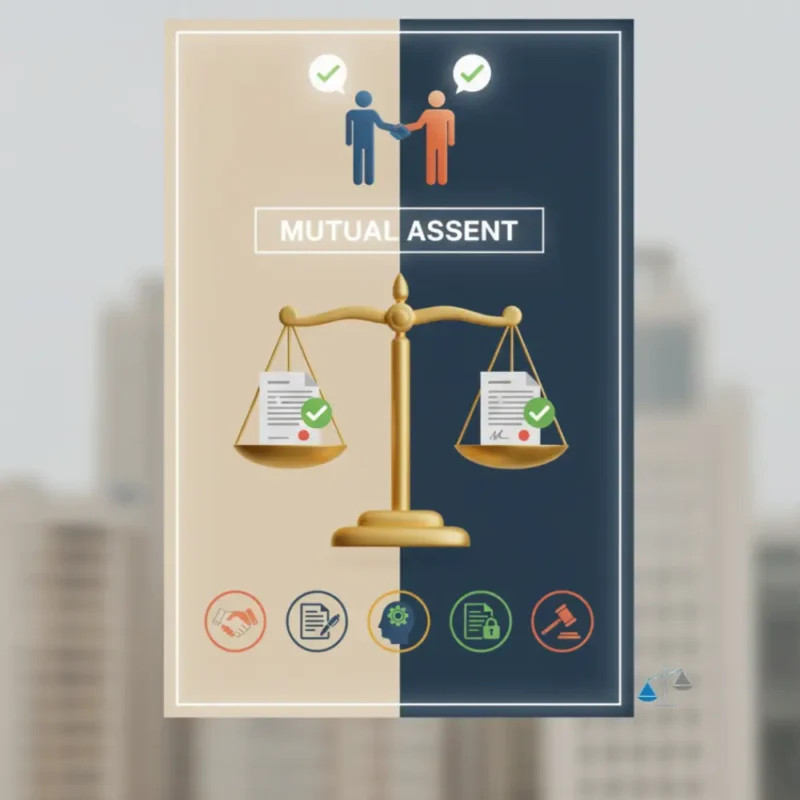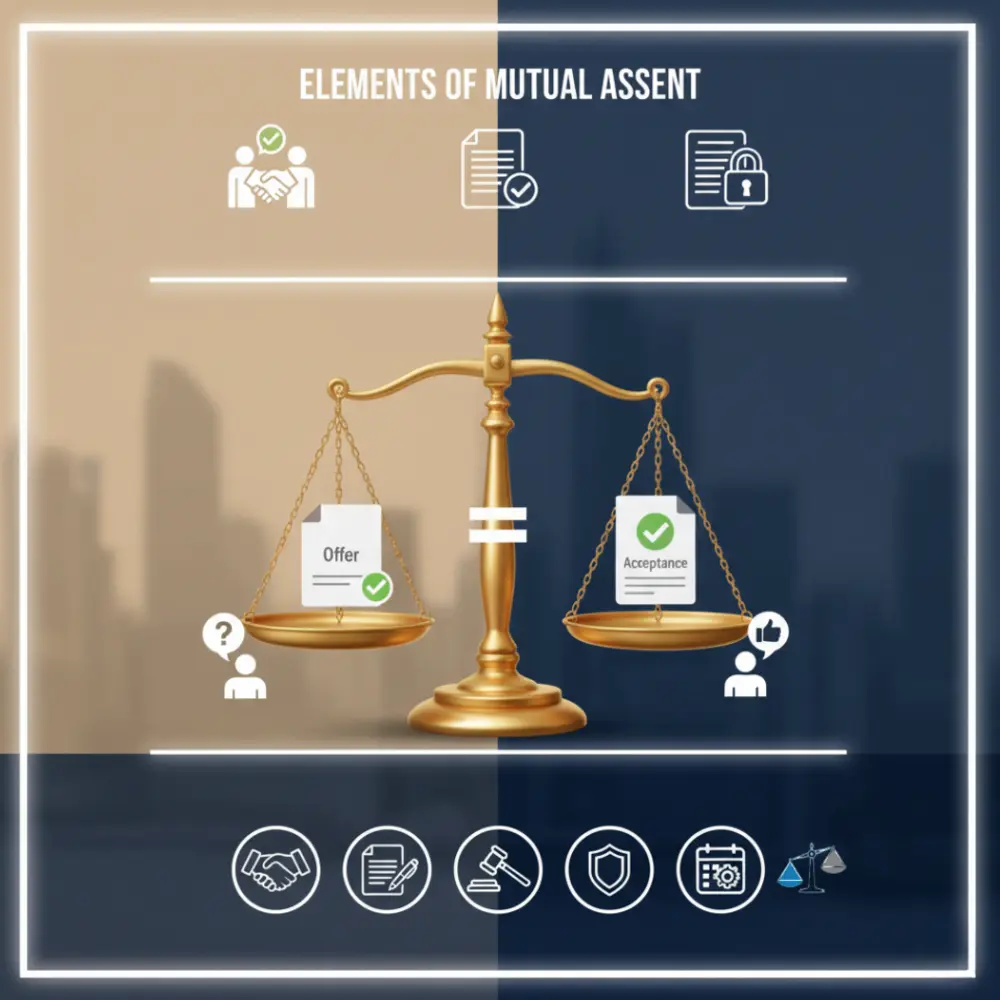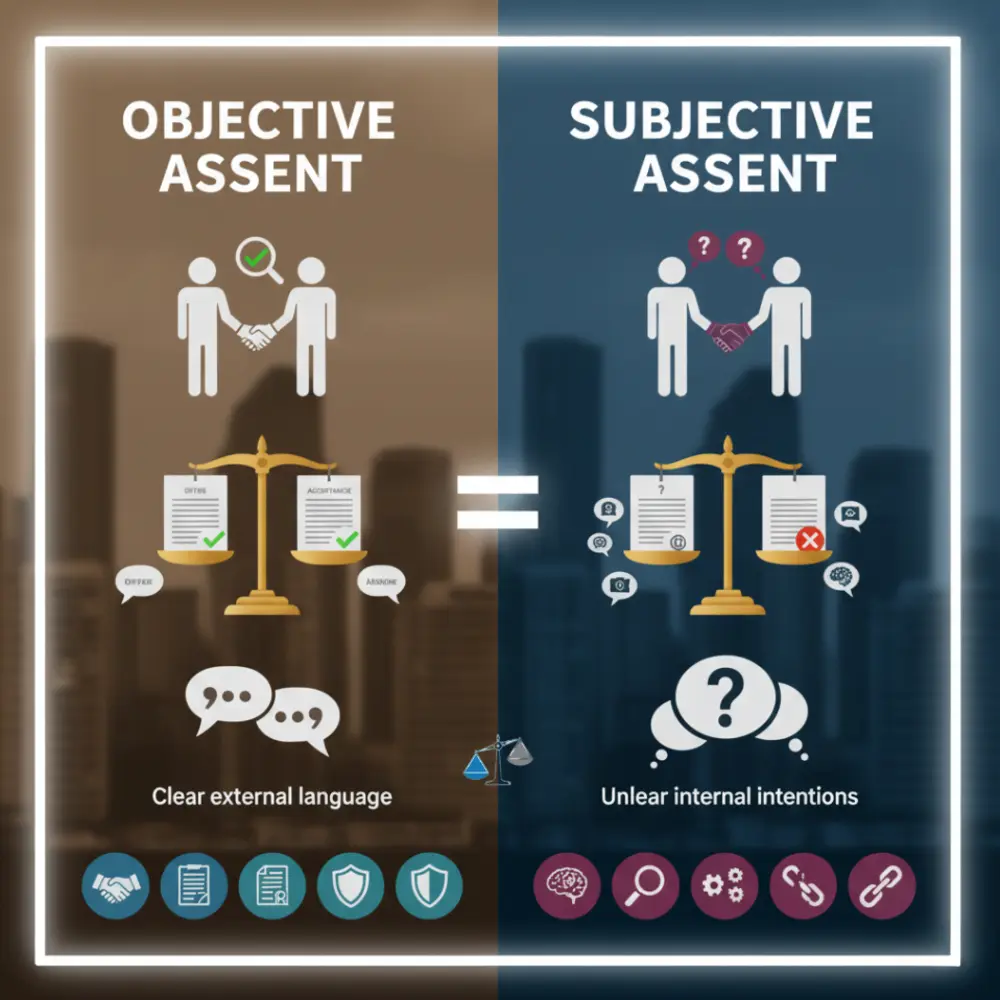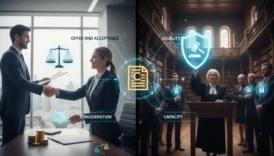Mutual Assent: Meeting of the Minds in Contracts

- Mutual Assent: Meeting of the Minds in Contracts
- Introduction to Mutual Assent
- Legal Definition of Mutual Assent
- Core Legal Meaning
- Key Elements in the Definition
- Example in Practice
- Quick Reference Table
- Elements of Mutual Assent
- 1. Offer
- 2. Acceptance
- 3. Intention to Create Legal Relations
- 4. Communication of Agreement
- Practical Example
- Summary Table
- The Concept of “Meeting of the Minds”
- Historical Understanding
- The Objective Approach
- Key Elements of a “Meeting of the Minds”
- Example
- Comparison Table
- Objective vs. Subjective Assent
- Subjective Assent (Internal Intent)
- Objective Assent (Outward Manifestation)
- Why Objective Assent Prevails
- Quick Comparison
- Case Illustration: Lucy v. Zehmer (1954)
- Role of Communication in Mutual Assent
- Key Functions of Communication
- Communication in Practice
- Modern Challenges
- Common Issues Affecting Assent
- 1. Mistake
- 2. Misrepresentation
- 3. Fraud
- 4. Duress
- 5. Undue Influence
- Summary Table
- Mutual Assent in Business and Commercial Contracts
- Importance in Business Deals
- Examples in Practice
- Mutual Assent in International Commerce
- Summary Table
- Judicial Interpretations and Case Examples
- Lucy v. Zehmer (1954)
- Raffles v. Wichelhaus (1864) – “Peerless” Case
- Embry v. Hargadine, McKittrick Dry Goods Co. (1907)
- Modern Applications
- Lessons from Case Law
- Mutual Assent in Digital Contracts
- Clickwrap Agreements
- Browsewrap Agreements
- Shrinkwrap Agreements
- E-commerce Transactions
- Challenges in Digital Assent
- Summary Table
- Conclusion
- FAQs About Mutual Assent
- What does mutual assent mean in contract law?
- How is mutual assent shown?
- Is mutual assent the same as consideration?
- What happens if there is no mutual assent?
- Can silence amount to mutual assent?
- What issues can invalidate mutual assent?
- How do courts test for mutual assent?
- Does mutual assent apply to online contracts?
Introduction to Mutual Assent
At the core of every enforceable contract lies the principle of mutual assent, often described as a “meeting of the minds.” This concept captures the idea that both parties must agree to the same terms in the same sense for a contract to exist. Without it, even the most detailed agreement may be unenforceable, because the law requires more than words on paper—it requires genuine agreement.
Mutual assent is typically established through offer and acceptance, but it also depends on whether both parties share a clear understanding of the contract’s essential terms. Courts apply an objective standard, asking whether a reasonable observer would conclude that the parties intended to be bound, rather than relying solely on what the parties privately thought.
This doctrine ensures fairness and predictability. For example, if one party believes they are buying a car while the other thinks they are only discussing a rental, there is no true meeting of the minds, and therefore no enforceable contract. In modern practice, mutual assent applies not only to written agreements but also to oral contracts, digital transactions, and even conduct that shows intent to be bound.
In this article, we will explore the legal definition of mutual assent, its essential elements, the role of communication, challenges such as mistake or misrepresentation, and how courts apply the principle in both traditional and digital contexts. By the end, you will see why mutual assent is considered the foundation of contractual enforceability.
Legal Definition of Mutual Assent
In contract law, mutual assent refers to the agreement between parties to enter into a binding contract, demonstrated by their words, actions, or conduct. It is often called a “meeting of the minds,” though courts today apply an objective standard rather than searching for subjective intentions.
Core Legal Meaning
- Agreement on Terms: Both parties must understand and agree to the same essential terms.
- Intent to Be Bound: There must be evidence that the parties intended the agreement to carry legal consequences.
- Objective Test: Courts ask whether a reasonable person observing the exchange would conclude that an agreement was made, regardless of undisclosed personal thoughts.
Key Elements in the Definition
- Offer and Acceptance – Mutual assent is typically achieved when a valid offer is made and accepted.
- Clarity of Terms – Essential terms such as subject matter, price, and obligations must be clear.
- Communication – Both parties must be aware of the agreement; uncommunicated intentions cannot form assent.
Example in Practice
If a seller offers to sell a car for $15,000 and the buyer agrees to pay that amount, there is mutual assent. However, if the seller thought they were selling one car while the buyer thought they were buying another, the lack of shared understanding would prevent a binding contract.
Quick Reference Table
| Requirement | Legal Effect | Example |
|---|---|---|
| Agreement on Terms | Creates enforceability | Both parties agree on car and price |
| Intent to Be Bound | Shows legal commitment | Signing a written contract |
| Objective Standard | Courts look at outward actions | Shaking hands after negotiation |
| Communication | Awareness required | Buyer informed of price before acceptance |
“Mutual assent exists not in hidden intentions, but in the outward expression of agreement.”
Elements of Mutual Assent

Mutual assent is not a single act but the result of several components working together. Courts look for these elements to determine whether parties truly reached an agreement that the law will enforce.
1. Offer
A valid offer is the starting point. It must present clear and definite terms and show an intention to be legally bound if accepted. Without a valid offer, there can be no mutual assent.
2. Acceptance
Acceptance is the offeree’s unqualified agreement to the offer’s terms. It must mirror the offer exactly, without introducing new conditions. Acceptance can be expressed through words, conduct, or even performance, depending on the nature of the contract.
3. Intention to Create Legal Relations
For assent to be valid, the parties must intend their agreement to have legal consequences.
- In business and commercial contexts, this intention is generally presumed.
- In social or domestic contexts, such as family promises, courts often assume there was no intention unless proven otherwise.
4. Communication of Agreement
Mutual assent requires that the agreement be communicated. One party cannot be bound by secret intentions or unspoken agreements. This ensures that both parties are fully aware of what they are entering into.
Practical Example
Imagine two parties negotiating a software license:
- The provider offers a license for $5,000 annually.
- The customer accepts those terms without changes.
- Both intend to enter a legally binding agreement, and the acceptance is communicated via email.
Here, all four elements—offer, acceptance, intent, and communication—are satisfied, creating mutual assent.
Summary Table
| Element | Requirement | Example |
|---|---|---|
| Offer | Clear, definite terms | Software license offered for $5,000 |
| Acceptance | Must mirror offer | Customer agrees without changes |
| Intention | Must intend legal binding | Commercial contract presumed binding |
| Communication | Parties must be aware | Acceptance confirmed by email |
“Mutual assent requires more than words—it requires clear terms, intent, and communication.”
The Concept of “Meeting of the Minds”
The phrase “meeting of the minds” is one of the most famous expressions in contract law. It reflects the idea that both parties must agree to the same thing, in the same sense, at the same time. Although modern courts rely on an objective test rather than subjective beliefs, the concept still captures the essence of mutual assent.
Historical Understanding
Traditionally, contract law emphasized that a contract could only exist if both parties truly shared the same understanding of the agreement. This strict interpretation often made contracts vulnerable to claims of misunderstanding, even if outward conduct suggested agreement.
The Objective Approach
Today, courts look not at what the parties secretly thought but at what they communicated through words or actions. The law presumes that reasonable observers can judge whether the parties intended to form a binding agreement. This shift provides stability and reduces the risk of one party later denying the existence of a contract.
Key Elements of a “Meeting of the Minds”
- Clarity of Terms: Both sides must understand essential elements like price, subject matter, and obligations.
- Consistency of Intent: Both must intend to enter into a legally binding agreement.
- Manifestation of Agreement: Actions, signatures, or conduct must show assent.
Example
If a landlord and tenant negotiate a lease and both sign a written document specifying the rent, duration, and conditions, there is a clear meeting of the minds. However, if the landlord believed the rent was $1,500 and the tenant thought it was $1,200, no true meeting occurred, and the contract may be invalid.
Comparison Table
| Aspect | Subjective Approach (Old) | Objective Approach (Modern) |
|---|---|---|
| Focus | Internal thoughts | Outward expressions |
| Risk | Easy to dispute contracts | Greater stability |
| Example | “I didn’t mean it that way” | “Your signed agreement shows intent” |
“A contract is formed not by secret intentions but by the outward meeting of minds.”
Objective vs. Subjective Assent
A central question in contract law is whether courts should evaluate contracts based on what parties actually thought (subjective assent) or how their conduct appeared to a reasonable observer (objective assent). Modern law overwhelmingly favors the objective approach, but both perspectives help explain the development of mutual assent.

Subjective Assent (Internal Intent)
- Definition: Focuses on the actual state of mind of each party.
- Limitation: Difficult to prove because internal thoughts are private and unverifiable.
- Example: If a person jokingly offers to sell their car for $1,000, but the other party takes it seriously, the subjective view would hold no contract exists because the offeror never truly intended to sell.
Objective Assent (Outward Manifestation)
- Definition: Focuses on what a reasonable observer would conclude from the parties’ words and actions.
- Advantage: Provides clarity, predictability, and fairness.
- Example: In the same car sale situation, the objective approach might enforce the agreement if the offeror’s actions reasonably appeared serious.
Why Objective Assent Prevails
- Ensures stability in business and personal agreements.
- Prevents dishonest parties from escaping obligations by claiming hidden intentions.
- Reduces litigation by providing a clear test: Would a reasonable person believe a contract was formed?
Quick Comparison
| Aspect | Subjective Assent | Objective Assent |
|---|---|---|
| Focus | Internal thoughts | Outward expressions |
| Proof | Difficult to verify | Based on evidence and conduct |
| Legal Use Today | Rare, limited cases | Standard approach |
| Example | “I was joking” | Signed contract treated as serious |
Case Illustration: Lucy v. Zehmer (1954)
- Facts: Zehmer wrote on a napkin that he would sell his farm for $50,000, later claiming it was a joke.
- Ruling: The court enforced the contract, holding that Zehmer’s outward conduct showed serious intent.
- Lesson: Objective assent outweighs hidden subjective intent.
“The law of contracts enforces what people do and say, not what they secretly think.”
Role of Communication in Mutual Assent
Mutual assent cannot exist without effective communication. For two parties to reach a true agreement, they must exchange clear information about their intentions and obligations. Courts consistently hold that unspoken or hidden intentions are irrelevant—what matters is what is communicated.
Key Functions of Communication
1. Establishing Awareness
- Both parties must know the essential terms of the agreement.
- A party cannot assent to something they are unaware of.
- Example: A customer cannot accept a hidden fee in a service agreement if it was never disclosed.
2. Preventing Misunderstandings
- Clear communication ensures both parties share the same interpretation.
- Ambiguous terms can prevent the formation of a valid contract.
- Example: Agreeing to deliver “a shipment of goods” is vague; specifying “1,000 laptops” avoids disputes.
3. Demonstrating Intent
- Communication provides evidence of intent to be bound.
- This can be done through words, actions, or written documents.
- Example: Signing a written contract or replying to an offer email.
4. Timing of Communication
- Acceptance must be communicated while the offer is still valid.
- If the offer has lapsed or been revoked, communication of acceptance is ineffective.
Communication in Practice
| Communication Element | Legal Effect | Example |
|---|---|---|
| Disclosure of Terms | Creates awareness | Contract states price and conditions |
| Clarity of Terms | Prevents disputes | Specifying “1,000 laptops” |
| Expression of Intent | Shows readiness to be bound | Signed contract |
| Timing | Must be within validity of offer | Accepting before revocation |
Modern Challenges
- Email and Instant Messaging: Courts treat acceptance as valid when received, not just when sent.
- Online Contracts: “Click to accept” is valid communication if terms are displayed.
- Silence: Generally not considered communication unless conduct shows otherwise.
“In contract law, mutual assent is measured not by hidden thoughts, but by communicated intent.”
Common Issues Affecting Assent
Even when offer, acceptance, and communication appear valid, mutual assent can be undermined by certain issues that call into question whether the agreement was genuine. Courts closely examine these situations to ensure that contracts are formed on the basis of true and voluntary consent.
1. Mistake
- Unilateral Mistake: One party misunderstands the terms while the other does not. Courts rarely void contracts for unilateral mistakes unless the error is obvious.
- Mutual Mistake: Both parties are mistaken about an essential fact. In such cases, the contract may be void because there was no true meeting of the minds.
- Example: Both buyer and seller believe a painting is an original, but it turns out to be a copy.
2. Misrepresentation
- When one party is induced to agree by false statements.
- Misrepresentation may be innocent, negligent, or fraudulent.
- Example: A seller claiming a car has never been in an accident when it has.
3. Fraud
- Intentional deception designed to secure assent.
- Contracts formed through fraud are voidable at the option of the innocent party.
- Example: Falsifying financial records in a business sale.
4. Duress
- When a party’s consent is obtained through threats, violence, or coercion.
- Contracts signed under duress lack valid assent because agreement was not voluntary.
- Example: Forcing someone to sign a contract at gunpoint.
5. Undue Influence
- Occurs when one party exploits a position of trust or authority to pressure another into agreeing.
- Common in relationships like parent-child, lawyer-client, or caregiver-elderly.
- Example: An elderly person pressured by a caregiver to transfer property.
Summary Table
| Issue | Effect on Assent | Example |
|---|---|---|
| Mistake | Can void contract if mutual | Misidentified subject of sale |
| Misrepresentation | Makes contract voidable | Seller gives false info |
| Fraud | Voidable due to deceit | Fake financial documents |
| Duress | Invalidates consent | Threat-based agreement |
| Undue Influence | Agreement not freely given | Caregiver pressuring elder |
“True consent cannot exist where mistake, deception, or coercion controls the agreement.”
Mutual Assent in Business and Commercial Contracts
In business and commercial contexts, mutual assent is not just a legal formality—it is the foundation of trust and enforceability. Every commercial relationship, from small vendor agreements to billion-dollar mergers, relies on the principle that both sides clearly understand and agree to the same terms.
Importance in Business Deals
- Predictability: Ensures that obligations are clear and enforceable.
- Risk Management: Prevents disputes by clarifying duties before performance begins.
- Efficiency: Allows businesses to operate smoothly by relying on enforceable commitments.
Examples in Practice
- Supply Contracts
- A supplier agrees to deliver raw materials at a fixed price.
- Mutual assent exists when the buyer accepts the terms and places an order.
- Employment Agreements
- An employee agrees to perform specific tasks in exchange for salary and benefits.
- Assent is shown through signing the employment contract or beginning work under agreed conditions.
- Partnership and Joint Ventures
- Two businesses agree to collaborate on a project, sharing profits and responsibilities.
- Assent is clear when terms are negotiated and documented.
- Loan and Financing Arrangements
- A lender provides capital in exchange for repayment with interest.
- Both sides explicitly agree to terms like repayment schedule and interest rate.
Mutual Assent in International Commerce
Cross-border transactions depend heavily on clear assent, as differences in legal systems and languages can create disputes. To safeguard mutual assent, businesses often:
- Use standardized contracts like the CISG (United Nations Convention on Contracts for the International Sale of Goods).
- Require written confirmations of terms.
- Employ neutral languages, such as English, for international agreements.
Summary Table
| Business Context | Assent Example | Importance |
|---|---|---|
| Supply Contracts | Buyer accepts supplier’s terms | Ensures delivery and pricing certainty |
| Employment | Employee signs contract or starts work | Defines rights and duties |
| Partnerships | Agreed terms in joint venture | Clarifies profit-sharing |
| Loans | Agreement on repayment & interest | Protects both lender and borrower |
| International Trade | Written agreements, CISG rules | Reduces cross-border disputes |
Judicial Interpretations and Case Examples
Courts have shaped the modern understanding of mutual assent through landmark decisions. These cases illustrate how judges apply the principle of a “meeting of the minds” and the objective test of agreement.
Lucy v. Zehmer (1954)
- Facts: Zehmer agreed in writing, on a restaurant napkin, to sell his farm for $50,000, later claiming it was a joke.
- Ruling: The court enforced the contract, holding that a reasonable person would view the written agreement as serious.
- Lesson: Objective conduct, not hidden intent, determines assent.
Raffles v. Wichelhaus (1864) – “Peerless” Case
- Facts: A contract to ship cotton on the ship Peerless failed because there were two ships with the same name, leading to confusion about which ship was intended.
- Ruling: The court held there was no contract due to lack of mutual assent on an essential term.
- Lesson: A contract cannot exist without shared understanding of key details.
Embry v. Hargadine, McKittrick Dry Goods Co. (1907)
- Facts: An employee claimed his employer promised renewal of his contract during a conversation.
- Ruling: The court applied the objective test, holding that what a reasonable person would have understood controlled the outcome.
- Lesson: Outward expressions, not internal thoughts, establish assent.
Modern Applications
In digital and e-commerce cases, courts often enforce “clickwrap” agreements, where users click “I agree.” Even if users do not read the terms, the act of clicking is treated as valid assent because it shows outward agreement to the contract’s conditions.
Lessons from Case Law
| Case | Key Principle | Takeaway |
|---|---|---|
| Lucy v. Zehmer | Objective test prevails | Jokes don’t negate contracts if conduct appears serious |
| Raffles v. Wichelhaus | No agreement if essential term unclear | Ambiguity defeats assent |
| Embry v. Hargadine | Reasonable person standard | Courts judge outward words and conduct |
| Modern Digital Cases | Clickwrap agreements enforceable | Clicking = assent in online contracts |
“Judicial precedent confirms that mutual assent rests on how agreements appear, not on what parties secretly think.”
Mutual Assent in Digital Contracts
In the digital age, mutual assent is just as important as in traditional contracts, but it often appears in new forms. Online shopping, mobile applications, and cloud-based services all rely on assent that may not involve handwritten signatures or face-to-face negotiations. Courts have adapted the principle of mutual assent to these modern realities while still requiring clear evidence of agreement.
Clickwrap Agreements
- Definition: Users must click “I agree” or a similar button before accessing a service.
- Legal Standing: Courts consistently uphold clickwrap agreements as enforceable because they require active assent.
- Example: Signing up for a streaming platform after clicking “I accept the terms.”
Browsewrap Agreements
- Definition: Terms of service are posted on a website but do not require active agreement.
- Challenge: Courts are less likely to enforce these contracts since users may not be aware of the terms.
- Example: A website that states “use of this site constitutes agreement to our terms,” without requiring a click.
Shrinkwrap Agreements
- Definition: Found in software packaging, where terms are enclosed inside.
- Acceptance: Opening or using the product is treated as assent.
- Example: Installing software after unsealing packaging that contains terms.
E-commerce Transactions
- Online shopping platforms demonstrate assent through a simple process:
- Product listing = invitation to treat.
- Customer order = offer.
- Seller confirmation = acceptance.
This structure ensures a digital “meeting of the minds” despite the lack of physical interaction.
Challenges in Digital Assent
- Unread Terms: Most users do not read lengthy online agreements, yet courts still enforce assent.
- Jurisdictional Issues: Online contracts may raise disputes about which country’s laws apply.
- Automated Contracts: Algorithms and bots can enter into agreements, raising questions about how assent is demonstrated.
Summary Table
| Type of Digital Assent | Enforceability | Example |
|---|---|---|
| Clickwrap | Strongly enforceable | Clicking “I agree” on app signup |
| Browsewrap | Weak enforceability | Website terms without consent button |
| Shrinkwrap | Enforceable if product used | Software license in packaging |
| E-commerce | Structured process | Order → Confirmation = contract |
“Even in digital spaces, the law requires a meeting of the minds—expressed through clicks, taps, or digital confirmations.”
Conclusion
Mutual assent remains one of the most fundamental principles in contract law. It ensures that agreements are not just exchanges of promises but enforceable commitments built on clear, shared understanding. Without mutual assent, contracts would collapse into uncertainty, as parties could dispute whether they ever truly agreed.
From its roots in the idea of a “meeting of the minds” to its modern application in digital commerce, the doctrine has proven remarkably adaptable. Courts no longer focus on hidden intentions but instead apply the objective test: would a reasonable observer conclude that both parties intended to be bound? This approach provides stability, predictability, and fairness in both personal and commercial relationships.
In business contexts, mutual assent protects investments, clarifies obligations, and reduces disputes. In digital contexts, it ensures that even a simple click can demonstrate legally enforceable agreement. At the same time, doctrines such as mistake, fraud, duress, and undue influence safeguard against false or coerced consent.
Ultimately, mutual assent is more than a legal technicality—it is the lifeblood of contract law. It ensures that contracts rest on fairness, communication, and shared intent, creating trust between parties and making commerce, employment, and personal agreements possible.
FAQs About Mutual Assent
What does mutual assent mean in contract law?
Mutual assent means that both parties agree to the same terms with the intent to form a legally binding contract. It is often described as a “meeting of the minds.”
How is mutual assent shown?
It is usually demonstrated through offer and acceptance, supported by clear communication. In modern contexts, assent can also be shown by conduct, such as clicking “I agree” in an online contract.
Is mutual assent the same as consideration?
No. Mutual assent refers to agreement on terms, while consideration refers to the exchange of value that makes the contract enforceable. Both are required for most valid contracts.
What happens if there is no mutual assent?
If parties do not share the same understanding of essential terms, no valid contract is formed. Courts may declare the agreement void or unenforceable.
Can silence amount to mutual assent?
Generally, silence is not enough. However, if conduct clearly shows agreement, or if the parties’ prior dealings treat silence as acceptance, it may establish assent.
What issues can invalidate mutual assent?
Mistake, misrepresentation, fraud, duress, and undue influence can all undermine genuine assent, making the contract void or voidable.
How do courts test for mutual assent?
Courts apply an objective test: Would a reasonable person observing the words and conduct of the parties believe that an agreement was reached?
Does mutual assent apply to online contracts?
Yes. Courts uphold clickwrap and similar agreements as valid forms of assent, as long as terms are presented clearly and the user takes affirmative action to agree.





